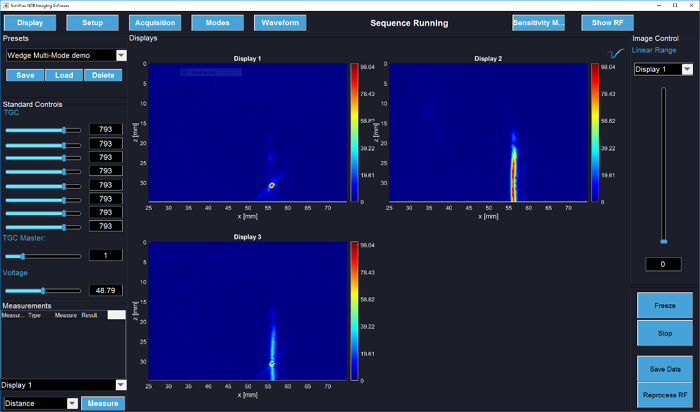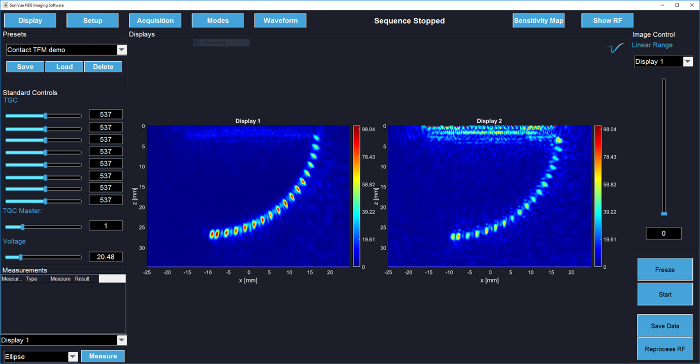Welcome to the sixth issue of Volume 5 of PLANE WAVE, Verasonics’ Newsletter through which we share information about new products and technologies, emerging applications, conferences, training opportunities, and collaborations with researchers in ultrasound and ultrasonic technologies. We hope you find these newsletters informative and interesting, and welcome your suggestions for future topics.
New Products & Technologies ▪ Emerging Applications ▪ Conferences & Training Opportunities ▪ Collaborations with Researchers
Introducing Non-Destructive Evaluation (NDE) Research Software
Verasonics’ NDE Research Software is a tool for advanced, high-speed, and custom array imaging, designed to support research and development. This user-friendly software package is designed to complement Verasonics’ existing programming model, providing advanced real-time imaging and convenient data acquisition without the need for programming by the user.
Through the support of user-developed and tailored imaging modes, NDE Research Software provides an innovative platform for rapid prototyping of new applications. This can save valuable time and resources, and assist the delivery of research and development outcomes, within or between organizations, with all the convenience and utility of an advanced imaging software package.
Multi-mode TFM
The core functionality of the software is full matrix capture (FMC) and multi-mode total focusing method (TFM) imaging. Multiple simultaneous image displays can be created, each of which can contain any arbitrary combination of imaging modes. Native imaging modes include all mode conversion permutations of direct, half-skip, and full-skip TFM. Imaging is supported for one or two array configurations with arrays either in direct contact or through a stand-off medium (e.g., wedge or immersion) for planar or curved surface geometry. Acquisition features include FMC, HMC, and Hadamard encoding. An example of direct and half-skip multi-mode imaging of a fatigue crack is shown in Figure 1.

Figure 1: Multi-mode wedge imaging of a fatigue crack. Direct + half-skip TFM.
Tools
Several convenient tools and features are provided, including a signal viewer for real-time plotting of RF data signals and power spectra, array and material databases and settings pre-set saving/loading functionality. A sensitivity mapping tool provides spatial sensitivity maps for the modes in each display window, computed for both point-like and planar reflector defect types. A range of image measurement and annotation tools are also included. Acquired data can later be loaded and reprocessed, for example at higher resolution, using different displays/modes or to re-analyze the data using custom modes developed after the original acquisition.
Custom Imaging
In addition to the native imaging modes, the software supports the addition of custom user-developed imaging techniques. Once imported, these modes can be selected by the user for use independently, or alongside any combination of native imaging modes. This enables both real-time, quantitative comparison with established techniques and allows the user to benefit from complementary attributes of both modalities.
Custom Look-up Table Modes
One type of custom mode makes use of Verasonics’ imaging reconstruction for custom applications of TFM such as non-standard geometry, or material properties (e.g. inhomogeneity or anisotropy). Verasonics’ image reconstruction is a fast proprietary implementation of delay-sum post-processed beamforming. In the context of generalized TFM, Verasonics’ reconstruction uses look-up tables of phase delays and amplitude weightings to apply post-processed focusing and generate an image. The user can provide a function to compute look-up tables for their custom application conditionally on user settings, allowing users to leverage the speed and accuracy of Verasonics’ image reconstruction for their own custom application.
Custom Processing Modes
Alternatively, custom modes can replace Verasonics’ image reconstruction, processing the raw RF signal data directly with any custom method. In the example shown in Figure 2, the left display is using direct mode TFM as a native imaging mode and the right display is using DORT (decomposition of the time-reversal operator), implemented through a custom processing mode.

Figure 2: Custom processed imaging in NDE Research Software: Native direct TFM and custom processing DORT.
Customer Research Spotlight: Learn How Some Verasonics Customers are Advancing Research in NDE
3-D Acoustic Tweezers Using a 2-D Matrix Array With Time-Multiplexed Traps by Hairong Zheng, Qi Hu, et al.
Self-Navigated 3D Acoustic Tweezers in Complex Media Based on Time Reversal by Hairong Zheng, Ye Yang, et al.
A multi-element HIFU array system: Characterization and Testing for Manipulation of Kidney Stones by Mohamed A. Ghanem
Let Verasonics assist with your NDE research and development. Contact us to learn how to incorporate the NDE Research Software in your research.

